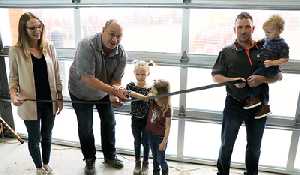Line 3 Segment Replacement Program: Enbridge plan would be the biggest project of its kind
September 3, 2013, 3:04 am
Kevin Weedmark


Enbridge’s Line 3 Segment Replacement Program would involve the largest decomissioning of a pipeline Enbridge has done, company officials said at an open house at Maryfield last week.
Enbridge is proposing to decomission a large segment of Line 3 and replace it with a new 36-inch pipe along the existing right-of-way. If approved by the National Energy Board, the work in southeast Saskatchewan would be done in 2015-2016.
Jason Jensen is assistant construction manager with Enbridge. He says the proposal for the Line 3 segment replacement will replace a problematic pipe with new pipe.
“It’s an integrity-driven project,” he says. “Our existing Line 3 was built back in the ‘60s. We monitor it, like all our lines, on an ongoing basis. It’s been a little bit problematic due to some of the coating through that era. We’ve had a significant number of integrity digs, so for economics and environmental impact, we decided to look at potentially replacing the line.”
The project is in the preliminary stages and no proposal has yet gone to the National Energy Board.
“It would be an offset of Clipper. It would be a similar footprint to that. We’re looking at 36-inch pipe, although nothing is set in stone.”
The existing 34-inch pipe would be left in place, subject to approval by the National Energy Board.
Construction through southeast Saskatchewan would start late in 2015, and the project would involve multiple crews of about 500 people each working on different segments of pipe at the same time.
Jensen said Enbridge would build on its experience from the Alberta Clipper project, which was built through the region four years ago.
“We’re fortunate that as of four or five years ago we were coming through with Clipper,” he says. “A lot of our stockpile sites we’re going to look at using again. A lot of where contractors yards were based out of, we would look at using the same locations. We were based in Moosomin last time.”
Jensen said a lot of work needs to be done in planning for construction.
“On the construction end of things, we have to finalize the route, crossing methodology, and perform any geotech work to determine any drills we might be looking at doing.”
“On the environment side, we’ve been actively gathering environmental data, but then again we have the Clipper data from four or five years ago as a benchmark.
“It makes it easier having done that project. We have all that data, and this pipe will be offset slightly from the Alberta Clipper. Presently we’re looking at a 10 metre offset from the Clipper.”
Jensen said there have been a lot of questions about the project at open houses “We’re getting a lot of questions about the pipe being left in the ground, and also about the timeline for construction.”
Enbridge Director of Engineering Vik Kohli is focusing on the decommissioning of Line 3.
“This whole project is really the next evolution in safe operations of pipelines,” he said. “It’s cutting edge in that regard. The historic way to do this is to dig up the line in multiple locations and do what we call an integrity dig. We can continue to do that with this line and do it in a safe manner and operate the line, but there comes a point where you have to look at the environmental side of the equation and the economic side of the equation in order to understand whether there’s a better option.
“The better option is putting new pipe in the ground. It’s less intrusive to the landowners, less intrusive to the environment, and the benefit to the company and to our regulator is that it’s new pipe, which means the latest technology, and better coatings.
“From that regard, the project is a breakthrough project for our industry, and perhaps other pipeline companies will follow suit.
“In terms of the decomissioning, we have to do something with the pipe that’s left in place and we’re really at this point restricted to two options. One is a really short term option which is to deactivate the line, which means someday we could put it back into service. We don’t see that as a viable option, so the only other option at this point is to decomission the line.
“The first step is cleaning the line, and how we do that is we run tools through the line to make sure it’s clean. Then, if required, we will put a biodegradable cleaning agent in the line and run some specific cleaning devices to ensure all the oil is removed.
“We physically disconnect the pipeline from any operating facilities and we would do a cut and cap, or put in an insulation plug that would basically seal it. It will be physically isolated at various points.”
In some areas, the pipeline will be filled with a material which will solidify. “At certain locations, there may be a need to put an inert material, a flowable fill, in the line,” said Kohli. That would be done in areas such as under rail lines where there may be some ground movement, and on river crossings to avoid the line “floating up.”
Kohli pointed out that Enbridge will maintain cathodic protection on the line and monitor the line. “Enbridge is responsible for the pipe as long as the pipe is there,” he said.
“It does seem that there’s a perception that’s been created that Enbridge will walk away from the pipeline if it’s left in place but not active. We double check with our lawyers and our regulatory people every time that comes up and the answer back is we can’t walk away, and we wouldn’t do that.
He said this project is a little different than those that have come before.
“As an industry, for 60 years, since 1950, we’ve really focused on building and operating pipelines in a responsible manner. The thought of decomissioning hasn’t really been the mindset. Now that’s starting to become a reality. We will put the same type of effort and engineering into the activities associated with decommissioning.”
Dan O’Neil is the environment lead for the Line 3 Segment Replacement Program.
He said he is hearing some general concerns over the project, including concerns from farmers over the impact of construction along the right-of-way on weed growth.
He said Enbridge takes the weed problem seriously. “We have a four phase strategy to control weeds. The first thing is to identify problem areas, the next step is to educate our crew—what are the problem areas, what kind of mitigation do we need to apply to prevent the spread of weeds or the introduction of weeds. The next step is to make sure we get things revegetated as quickly as we can and treat any areas that we know could become problematic, such as where adjacent land areas have weed issues. We typically run on a five-year post-construction monitoring program so we would typically have post-construction treatment throughout that period.”
The company also looks at its impact on wildlife and the landscape.
“We look at wildlife concerns, and migratory birds’ nesting sites, and crossing though wetlands and watercourses are big ones,” he said.
“We try to have as minimal impact as we can. We want to get the land back the way it was as soon as we can and not disturb the natural processes as much as we can.”
The environmental file is a large part of the submission to the National Energy Board. “We’ll file an application with an environmental and socio-economic assessment,” he said. “We have a wildlife specialist that looks at areas on the right-of-way, we have wetland specialists, we have aquatic specialists who look at fish habitat at major watercourse crossings, we have vegetation specialists who look at rare plants—all the environmental impacts,” he said.
“We also do a socio-economic assessment, looking at general concerns about when activities are taking place, how many people are coming to the area, the impact it will have on communities like Maryfield and some of those impacts are very positive.
“We find talking to local RMs that it’s very positive to have this business coming through their communities.
“In our environmental and socio-economic assessment we weigh all these thing, and lay out—if there is a potential impact—what kind of mitigation we can do. For example, we try to restrict our traffic to certain travel routes to minimize dust and noise issues, and minimize the impact on roads.
“The NEB application has several sections. There’s engineering, there’s our lands section, and there’s our environmental and socio-economic assessment which shows how overall this project will impact communities. That’s what the NEB looks at to decide is this project in the best interests of the public and should it go ahead.”



































